 I have never eaten at this restaurant. I love how it looks. It is one of the finest restaurants in Paris, sits on the Seine, and from its windows on an upper floor you can look at the sun setting behind the Notre Dame. Enter its web site, and you will experience the extravagance shown in the movie Marie Antoinette that I saw last week. I have been fortunate enough to eat at some fine restaurants in Paris, a once in a lifetime experience for most of us. If you ask me, almost anywhere you eat in Paris is wonderful, even the humblest café. The food is better than anywhere I've been. I have a theory that the omelettes are better in Paris because they do not refrigerate the eggs as we do in the U.S.
I have never eaten at this restaurant. I love how it looks. It is one of the finest restaurants in Paris, sits on the Seine, and from its windows on an upper floor you can look at the sun setting behind the Notre Dame. Enter its web site, and you will experience the extravagance shown in the movie Marie Antoinette that I saw last week. I have been fortunate enough to eat at some fine restaurants in Paris, a once in a lifetime experience for most of us. If you ask me, almost anywhere you eat in Paris is wonderful, even the humblest café. The food is better than anywhere I've been. I have a theory that the omelettes are better in Paris because they do not refrigerate the eggs as we do in the U.S.Thursday, November 02, 2006
Tour d'Argent restaurant
 I have never eaten at this restaurant. I love how it looks. It is one of the finest restaurants in Paris, sits on the Seine, and from its windows on an upper floor you can look at the sun setting behind the Notre Dame. Enter its web site, and you will experience the extravagance shown in the movie Marie Antoinette that I saw last week. I have been fortunate enough to eat at some fine restaurants in Paris, a once in a lifetime experience for most of us. If you ask me, almost anywhere you eat in Paris is wonderful, even the humblest café. The food is better than anywhere I've been. I have a theory that the omelettes are better in Paris because they do not refrigerate the eggs as we do in the U.S.
I have never eaten at this restaurant. I love how it looks. It is one of the finest restaurants in Paris, sits on the Seine, and from its windows on an upper floor you can look at the sun setting behind the Notre Dame. Enter its web site, and you will experience the extravagance shown in the movie Marie Antoinette that I saw last week. I have been fortunate enough to eat at some fine restaurants in Paris, a once in a lifetime experience for most of us. If you ask me, almost anywhere you eat in Paris is wonderful, even the humblest café. The food is better than anywhere I've been. I have a theory that the omelettes are better in Paris because they do not refrigerate the eggs as we do in the U.S.Monday, October 09, 2006
Église de la Madeleine

Looking north from the Place de la Concorde, past this fountain, you can see the church dedicated to Mary Magdalene, at the end of rue Royale. Louis XVI was beheaded with the guillotine just near here in the square.
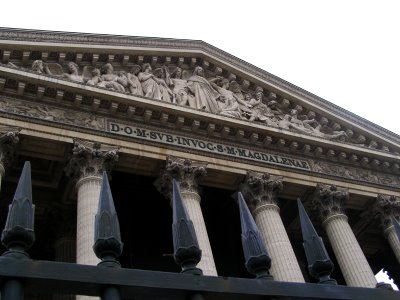
The Neo-Classical Église de la Madeleine is affectionately called "La Madeleine" by Parisians. There are 52 Corinthian columns around the edifice.
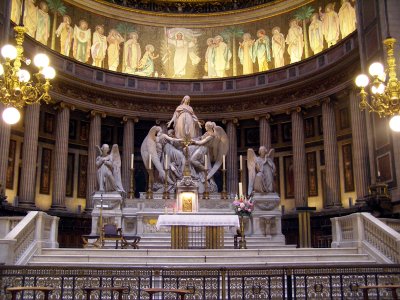
This statue inside is of Mary Magdalene's ascension. It was built in 1837 by Charles Marochetti.
 The painted frieze shows Jesus and the disciples.
The painted frieze shows Jesus and the disciples. I posted about Mary Magdalene in May, just as the movie "The DaVinci Code" was being released. I mentioned this church briefly then.
I posted about Mary Magdalene in May, just as the movie "The DaVinci Code" was being released. I mentioned this church briefly then.Two separate plans for this church were scrapped, the first in 1776 and the second in 1790.Then Napoléon thought Paris needed a temple to his army, and commissioned it to be completed as that honorary building. However, that too was scrapped for the Arc de Triomphe instead. In 1814 Louis XVIII decided it needed to be a church, but it was almost redesigned into Paris' first train station in 1837. Since 1842 it's been a church. (Information found at http://www.paris.org/Monuments/Madeleine/)
In 1969 the Catholic Church admitted quietly that there was no biblical basis for Mary Magdalene being a prostitute.
Every day except Monday there is a flower market around the church.
 Edouard Leon Cortes(1882 - 1969) Flower Market at the Madeleine, Oil on canvas
Edouard Leon Cortes(1882 - 1969) Flower Market at the Madeleine, Oil on canvasFriday, June 23, 2006
Pont des Arts

Pont des Arts is the best known pedestrian bridge in Paris. It may be the only pedestrian bridge, but since I haven't walked the Seine all the way to the perimeters of the city, I can't be sure.

Renoir's painting of pont des Arts, 1867
This was Sabrina's favorite bridge in the 1990s version of the movie of the same name.
It was Paris' first iron bridge, erected in 1803.
This fellow dressed up to show off his antler handlebars, and now that I think of it, I'm guessing he wanted a tip. But I was too busy photographing the Pont Neuf to be conscious of it. Oops. He has to make a living, and I didn't do my part.

Here's the view of the Pont Neuf and the Île de la Cité from Pont des Arts, looking east.

Monday, May 08, 2006
Mary Magdalene in Paris
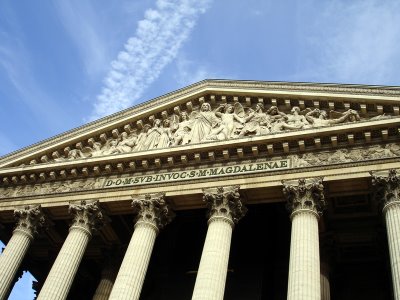
May 19 the film “The DaVinci Code” will be released worldwide to church controversy. Many will boycott the film, because it goes against traditional church teaching about Jesus’ relationship with Mary Magdalene. (Since when do books and movies have to be based in fact? Well, but when you’re talking about the marriage status of Jesus, the figurehead of one of the world’s great religions . . .)
I had my own Paris adventure with Mary Magdalene in 2004.
That year I was reading the book The DaVinci Code at about the same time I was learning more about Mary Magdalene (MM) from a spiritual teacher I met. Before then I didn’t know, for instance, that MM and others of Jesus' disciples may have escaped persecution in the Holy Land to Provence.
Mary, the name of the spiritual teacher, told me I was a “Magdalene” in a previous life, a follower of MM who joined her in fleeing Israel to France. I don’t accept or deny this claim, nor do I feel any particular attachment to MM, other than to find her story interesting theologically and sociologically. (Was she really a prostitute? Or did church leaders over the centuries misrepresent her because her role in Jesus’ life was outside social norms and thus beyond acceptance and comprehension?)
But because of the claim that I was a Magdalene, and because MM was said to have settled in France after fleeing Israel for her life after her friend and lord Jesus was killed, I set out on an already planned visit to Paris in October with companions with the new intention of visiting the Church of the Magdalene (Église de la Madeleine) and paying attention to any statuary I saw of her elsewhere in the city. Perhaps she would speak to me?
Église de la Madeleine, or simply “La Madeleine” was originally built as a temple to the glory of Napolean’s army in the 1760s. But after the fall of Napolean, King Louis XVIII decided to use it as a church. In the apse there is a statue of Mary Magdalene that looks very much as though she is pregnant, interestingly enough. Unfortunately I don't have a photograph to post here so you can decide for yourself. But believe me, either she is bending back in a limbo position, or she has a large abdomen!
After touring La Madeleine, Ginnie, Donica and I went to the Louvre on Monday, believing we had hours to browse (always check updated “ouverture” – opening and closing times at museums; old travel books don’t always have the current hours). It is said that if you spent 10 seconds standing before every display in the Louvre, it would take two months to see everything. It covers half a million square feet. We had 45 minutes before the museum closed.
We decided to go ahead and do “Louvre Light” (Louvre EXTRA Light) and feverishly dash around to see the Mona Lisa, the Winged Victory and Venus de Milo. Just before sprinting off to view these treasures, Donica noticed an enlarged photo of a Mary Magdalene statue on the Louvre map. Of course I had told my travel buddies about the “MM watch” and so we knew we had to go check out the statue.
Gregor Erhart was a 16th c. German sculptor who carved this gorgeous statue out of limewood c. 1500. From a distance, walking up the gallery toward her at the end of a long hallway, La Belle Allemande (as she is also called) is stunning in her life size elegance and quietude. But the true awe comes when you stand below her and gaze into her eyes, or rather, receive HER gaze. The only way to describe it (for when you feel it, it is indescribable) is to say that she comes alive, looks into your soul and communicates love and acceptance. How Mr. Erhart accomplished this I can’t comprehend. But I’m grateful to the museum designers and engineers who placed the statue at a perfect height to allow the effect.

Then, the museum was closing, and we had to leave, pulling ourselves reluctantly from MM’s captivating gaze.
Later in the week, we went back to the museum to see other rooms and displays, spending the two hours we’d anticipated on Monday. In spite of the intimate experience we’d had with her earlier in the week, we all agreed that we didn’t need to see MM again this visit. So we found the nearest elevator and began our exit from the Louvre. Reaching the lower ground floor (from where you enter and exit – under the glass pyramid), coming out of the elevator, we looked both ways to get our bearings, and there we were within a few feet of the Erhart MM statue! There she stood, bronze hair flowing, rose cheeks, mouth half smiling, eyes gazing down at whomever was standing beneath her. Stunned, we agreed that SHE wanted to say good-bye to US, and so, she did.
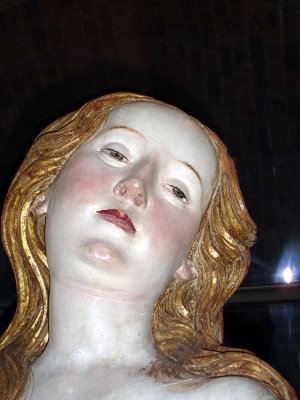
Photos courtesy Ginnie Hart and Donica Detamore
Monday, April 24, 2006
Montmartre: height and light

When the year turns to April or October, no matter where I am, my mind turns to walking the hills of Montmartre because of the way the sun slides down over the city in a low arc at this elevation (just 430 feet, but it feels high compared to the rest of the city).
The Butte, as Parisians call Montmartre, is the highest point in Paris and is on the Right Bank (north of the Seine). This means a lot of fairly steep uphill climbing to get to the top, often on cobblestones. You can see the hill, and its beacon, the Sacré-Cœur basilica, from many parts of the city. My favorite view of it is through the clock window at the Orsay museum on the Left Bank.

It is in the 18th arrondissement (Paris is divided into 20 arrondissements, each with its own mayoral center) and is where the movie Amelie was set.
Rue Foyatier is a tiny pedestrian street that is mostly stairs as you rise closer to the peak of the Butte (Pl du Tertre). With the Sacré-Cœur basilica (built from 1876 to 1912) in front of you (more like “above” you) you climb the step-street while the shortest and steepest métro line in Paris – the “funicular” -- runs up and down the same hill at your right.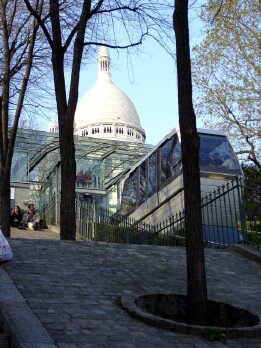
Views from the Sacré-Cœur’s turrets, or from its democratic steps where you sit next to high schoolers playing guitar and resting their young legs, are some of the best in the city.

Traces of the artists who lived and worked in Montmartre (Picasso, Pissaro, Van Gogh, Renoir, Utrillo, among them) can be found in their graves at the small St. Vincent cemetery and the larger Montmartre cemetery (some, not all, were buried here), in houses they painted or lived in, such as La Maison Rose painted by Utrillo and still pink, and the Montmartre Museum where the actor Rosimond lived.
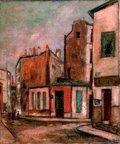 La Maison Rose by Maurice Utrillo
La Maison Rose by Maurice UtrilloThere is a constant reminder that Paris is a city for tourists: the tour bus. I’m not one who enjoys boarding a tour bus or watching buses line up at Paris hot spots. So I go to Montmartre on a weekday and wander the streets without as many tour buses blocking my view.
All photos courtesy of Donica Detamore and Ginnie Hart
Monday, April 17, 2006
Pont Neuf

Reproduced with permission from The Hector Berlioz Website (www.hberlioz.com)
In the role of Sabrina in the 1995 film of the same name, Julia Ormond said something like, “There are 26 bridges in Paris. You choose one and go to it in the morning with a croissant and coffee to write in your journal.” I believe her bridge was Pont des Arts.
My bridge is Pont Neuf. Although I have never journaled there, I could easily enough, since you can sit down in one of the alcoves that have benches. My brother Jim calls me “Reuf” to commemorate my affinity for this bridge. (I used “pont reuf” as an email address for a while.)
Although its name means “new bridge” it is the oldest existing bridge in Paris, begun by an order from Henry IV in 1578, completed around 1604. At the time, it was unusual for a bridge to be built without houses on it. A statue of Henry IV astride a horse sits in the park at the tip of the island in front of the bridge.
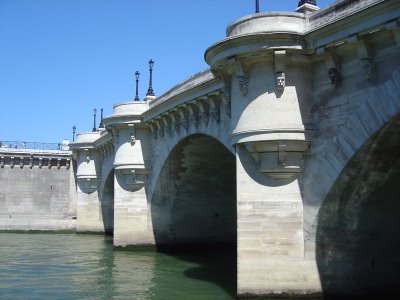 Copyright © 2003 David Monniaux
Copyright © 2003 David Monniaux
Even though there are “384 grotesques” – or carved heads, on the bridge, and although Pont Alexandre III is more elaborate, I think Pont Neuf is the most beautiful of the bridges. This can be good and bad. Good because there is a lot of art and photography of this bridge out there. Bad because it is a lot of other people’s favorite bridge, so it feels like a cliché to love it. Being one who always chose shoes the other girls weren’t wearing, this is a bit difficult. But I’m strong, and I’m almost over it.
It crosses the Seine and the tip of the Île de la Cité (on which the Notre Dame cathedral sits) at one of the most picturesque areas of the city. Five arches of the bridge cross the Seine south of the Île de la Cité, and seven arches of the bridge cross the Seine north of it.
 Copyright © 2003 David Monniaux
Copyright © 2003 David Monniaux
From one of my favorite vantage points of the city, the
Toupary restaurant on the 5th floor of the Samaritaine department store, there is a great view of the bridge. (I'll try to get that digital view next trip.)Pont Neuf stars in a 1991 movie along with Juliette Binoche:“Les Amants du Pont-Neuf” or “Lovers on the Bridge” – a sad story about homeless people who lived on the bridge while it was closed for repairs.
In 1985, Christo, the artist who constructed “The Gates” in 2005 in NYC’s Central Park created “Pont Neuf Wrapped” wrapping the entire bridge in 454,178 square feet of silky fabric.
What I tell myself when I start to ponder the fact that it might be considered a cliché to love Paris: There are a million reasons to back it up! It’s no accident! Mais bien sûr! But of course!
Here is a w hite chunk of construction detritus found on Pont Neuf in 2003 when it was being repaired and Don and I were in Paris for our 25th wedding anniversary; it now rests on a cabinet in my office.
hite chunk of construction detritus found on Pont Neuf in 2003 when it was being repaired and Don and I were in Paris for our 25th wedding anniversary; it now rests on a cabinet in my office.
David Monniaux photographs courtesy of the free usage agreement at Wikipedia.com (http://en.wikipedia.org/wiki/Pont_Neuf)


 Paris Time
Paris Time
